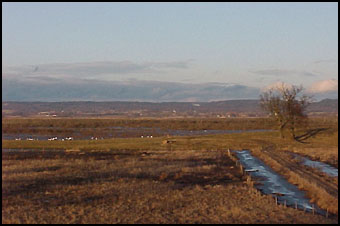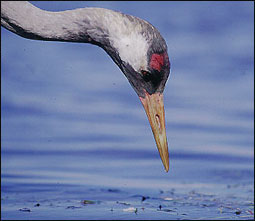VADBODEN |
| |
|
| The southernmost part of Lake Hornborga reaches road 184 between Falköping and Skara. This part of the lake has not been restored to the same extent as the northern part. It is still much overgrown with reed, grass and willow except of the part adjoining the road where trees and bushes have been removed and where experiments are being made to keep the country open by letting animales graze there. South of the
Church of Bjurum, Bjurumsån (the name of the small river) debouches into the lake. Near
the river ice-free water attracts birds that arrive in early spring, like ducks, swans and
geese. What to se: |
 |
| Cranes When winter ends and the feeding of the eagles ceases in February-March, Bjurumsån (the small lake) floods the surroundings of Vadboden, and open water makes early water birds gather here. In March you can find whooper swans, greylag geese, Canada geese, and different kind of ducks here. In the middle of March the first cranes arrive, and some weeks later there are thousands of them. There may be up to 10 000 cranes around Lake Hornborga in a single day during this period. Thousands of people interested in cranes visit the area every day admiring the big birds that can be seen at close range. If you are interested in the life and behaviour of birds, you have excellent possibilities of studying the cranes from the hill at "Trandansen". Early in the morning, with the rising sun in the background, the cranes come flying from their resting place in Lake Hornborga to land at Vadboden. There they will find barley which has been spread on the ground on the previous evening after they left for their night-quarters. If you have been standing here for a while watching the cranes, you will find that what you see is not just a flock of birds but isolated pairs that defend their range, their space and their feeding place. Something happens all the time. You can see both courtship and mating. If the wather is suitable for taking flight, you should, towards the middle of the afternoon, start looking for cranes coming from the south. They can bee seen at a long distance off and high up in the air before they land at Vadboden seemingly as if by means of a parachute. Towards the evening the activity
of the cranes is the most intense. At sunset the birds leave for their night-quarters. It
is a grand spectacle if 3000 to 4000 cranes take off almost at the same time. At the end
of April the massive invasion of cranes and tourists is over. |

